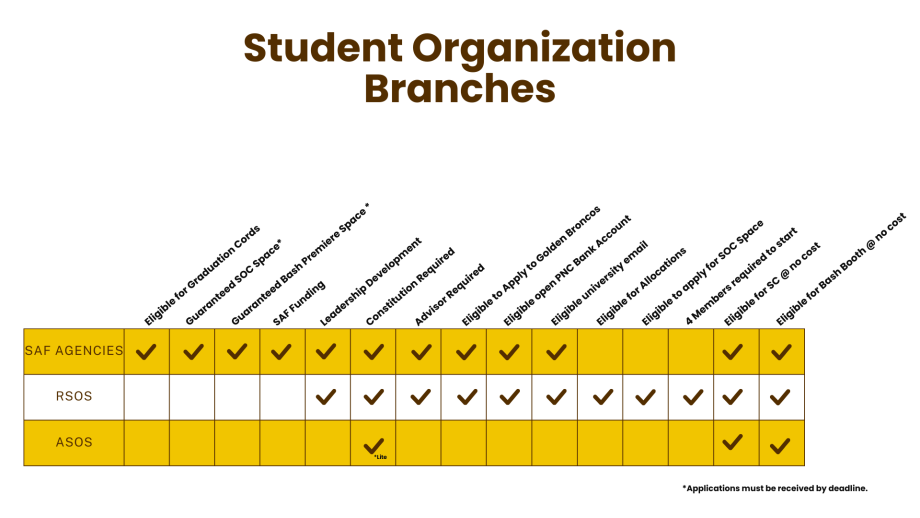3 Branch Structure
The Office of Student Engagement is excited to introduce a streamlined, three-branch model for student organizations. Designed to support your leadership, ensure accountability, and reduce risk, this new structure provides clear pathways for involvement while meeting the evolving needs of our campus community. All details are accessible through ExperienceWMU, where you can register your RSO or ASO.
Why the Change?
We’ve reimagined how student organizations are supported to:
- Foster Engagement & Belonging: By encouraging small group interactions and minimal requirements, we aim to build a stronger community where every student feels they truly belong with ASOs.
- Boost Leadership Development: Tailored training and mentorship opportunities prepare you for effective leadership for RSOs.
- Offer Flexibility: Three distinct tiers provide varying levels of autonomy and support, so you can choose the best fit for your group’s needs.
The Three Branches Explained
1. SAF Funded Organizations
Who They Are:
These organizations receive direct financial support from the Student Assessment Fee (SAF) and make up the SAF Council.
Key Requirements & Benefits:
- Requirements:
- Maintain a constitution outlining your mission and governance.
- Attend SAF Council meetings and submit periodic financial and programmatic reports.
- Complete a series of leadership training sessions covering topics like financial stewardship, event planning, and risk management.
- Work with an advisor experienced in SAF administration.
- Benefits:
- Guaranteed financial support for programming and operations.
- Access to specialized leadership development opportunities and coaching.
- Increased campus visibility and credibility, including eligibility for graduation cords.
- Guaranteed office space in the Student Organization Center (SOC) and reserved booth at Bronco Bash (if applications are timely).
2. Registered Student Organizations (RSOs)
Who They Are:
The largest category on campus, RSOs are officially recognized groups that enjoy a robust support system through training, and resources.
Key Requirements & Benefits:
- Requirements:
- Complete the university’s registration process with a current constitution and a minimum of four active members.
- Select an advisor who will complete OSE-provided training.
- Keep accurate records of membership, activities, and financial transactions.
- Benefits:
- Eligibility to apply for funding allocations and reserve on-campus spaces.
- Access to a WMU-affiliated email account, enhancing your organization’s professional image.
- Opportunities to apply for the Golden Bronco Awards.
- Structured leadership development and support to ensure your group’s growth and impact on campus.
3. Acknowledged Student Organizations (ASOs)
Who They Are:
ASOs are recognized student groups that operate with a high degree of independence and minimal oversight from OSE.
Key Requirements & Benefits:
- Requirements:
- Register with at least three people and a group name in ExperienceWMU.
- Constitutional requirements are lite.
- Limitations:
- ASOs do not receive specialized training or access to allocations.
- They are not eligible for Golden Broncos, SOC space, or official WMU email account.
- Benefits:
- Ability to reserve rooms on campus for meetings and events.
- Enjoy a greater degree of autonomy in how you run your organization.
What You Need to Know
- Clear Pathways: Choose the branch that best matches your organization’s needs. If you’re looking for robust financial and leadership support (SAF Funded), or comprehensive resources and training (RSOs), or greater independence (ASOs), you can create or join one that works best for your group.
- Structured Support: Each branch has specific requirements designed to help you succeed while ensuring responsible management of resources.
- Student-Centric: This change reflects our commitment to a more flexible, responsive campus environment, especially as student engagement evolves to match what the current students need and want.
Which One Is Right For My Org?
Frequently Asked Questions
Who are the SAF Agencies?
They currently are:
How do I determine which branch best fits my org?
Consider your group's priorities. Choose an RSO if you are looking for robust resources and leadership development and the ability to apply for funding. Choose ASO if you prefer a more independent approach with minimal requirements. If you are interested in becoming a <strong>SAF </strong>Agency, you need to make an appointment with SAF Council.
What training and leadership development opportunities will be offered?
Each branch offers tailored training sessions covering topics such as financial stewardship, event planning, risk management, and effective leadership. SAF Funded Organizations and RSOs, in particular, have access to specialized modules and coaching that help enhance both individual and group leadership skills.
How do I register my org?
Registration is done through the ExperienceWMU platform. You’ll need to submit the correct registration for each branch. Registration will open February 28, 2025 and be open through February 1, 2026.
Who can serve as an advisor for an RSO?
Advisors should be individuals who can serve and support your orgs needs. WMU does not pay advisors for these positions. They guide your organization, help make sure compliance, and support your leadership development.
My org has been an RSO for a couple of years. How will this structure change my org?
We don't anticipate a lot of change for currently registered orgs. Keep doing what you're doing! This will mostly affect brand-new organizations that want funding or that want autonomy.
Who do I contact if I have more questions?
For any further information or assistance, please reach out to the Office of Student Engagement. We are located in 3400 in the Student Center.








